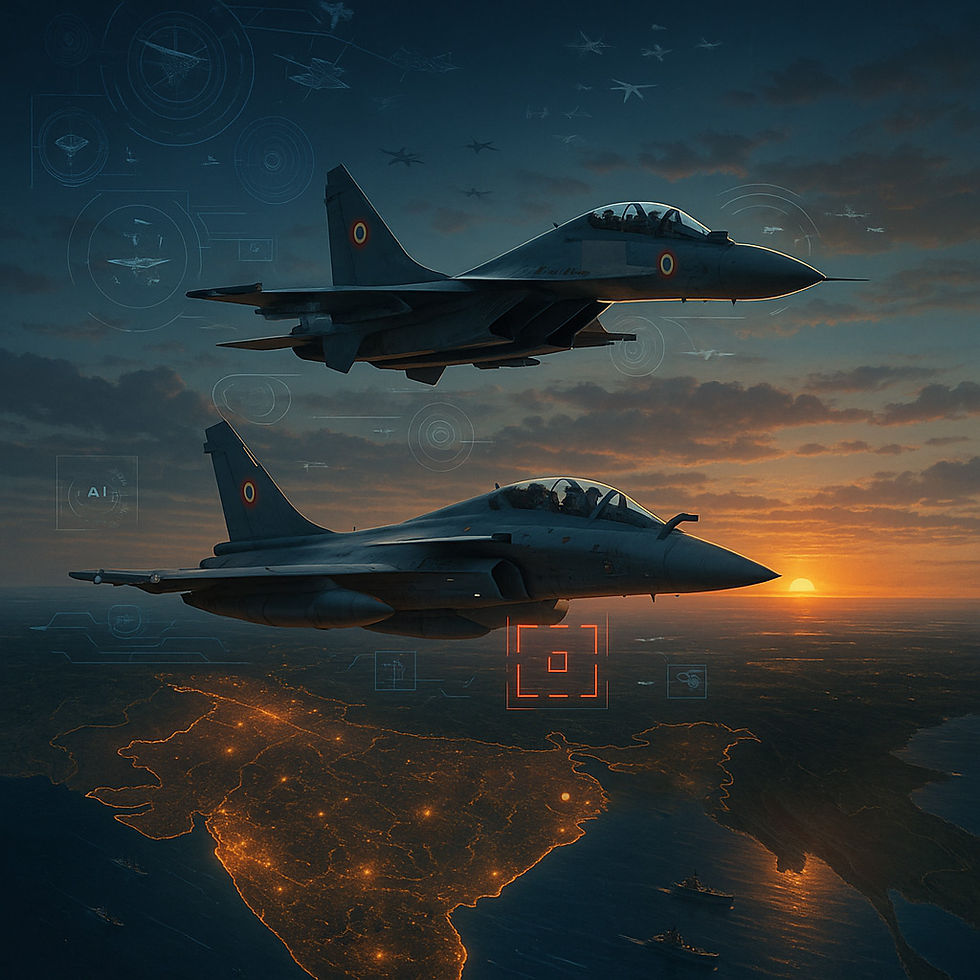Operation Sindoor and the Rise of Indian Air Dominance: A South Indian Brainpower Perspective
- President Nila
- May 19
- 3 min read
As of 16 May 2025, the Indian Air Force (IAF) stands as a formidable air power in South Asia. Its capabilities were boldly demonstrated during the recently concluded Operation Sindoor, where, within a mere 90 hours, India’s offensive air operations compelled Pakistani forces to request a ceasefire. The mission was not just swift but symbolically decisive — reshaping modern regional warfare.

This historic insight comes from a former Air Officer Commanding-in-Chief of the Western Air Command, the “sword arm” of the IAF. Though the officer prefers anonymity, his words reflect the pride and strategic confidence inspired by the operation.
Weapons, Alliances, and the Technology Behind Indian Air Power
India’s air superiority is not the result of chance, but of long-term partnerships, diversified procurement, and increasing self-reliance in defence technology.
1. Russian Legacy and Backbone (Approx. 65–70%)
Su-30 MKI: A custom-built multirole fighter, now modernised with Indian, Israeli, and French upgrades.
MiG-29 and MiG-21 Bison: Though ageing, they remain part of strategic and intercept roles.
Air-to-Air Missiles: Russian-origin R-77, R-73, and radar systems.
AWACS: Based on Il-76 aircraft, with both Russian and Israeli inputs.
2. French Precision Engineering
Rafale Fighters: Played a critical role in Operation Sindoor.
Meteor Missiles: Beyond-visual-range air dominance.
SCALP Cruise Missiles: Deep-strike precision against fortified enemy targets.
3. Israeli Technological Integration
SPICE-guided munitions: Used in both the Balakot airstrikes (2019) and Operation Sindoor.
Heron UAVs and loitering drones: Surveillance and precision engagement.
Phalcon AWACS: Israeli radars mounted on Russian platforms.
Litening Pods: Targeting enhancements for precision operations.
4. Indigenous Developments
BrahMos-A: Air-launched supersonic cruise missile on Su-30 MKI.
Tejas Mk1A: India’s Light Combat Aircraft, now entering squadron service.
DRDO Systems: Electronic warfare systems, radar jammers, and AI-based battle networks.
5. US and NATO Contributions
C-17 Globemaster, C-130J Super Hercules, Chinook, Apache: Logistics and firepower.
GE F-414 Engines and AESA Radars: Supporting India’s next-generation aircraft development.
South India: The Brain behind the Sky. South India possesses the brainpower that fuels much of India’s defence innovation.
Key Contributions:
Bengaluru, Hyderabad, Chennai, Coimbatore: Hubs for aerospace, cyber defence, and AI development.
Institutions like IISc, IIT Madras, and IIIT Hyderabad: Produce world-class engineers and defence researchers.
DRDO, ISRO, HAL, and Bharat Electronics Ltd (BEL): Predominantly operate from South India, fuelling India’s defence ecosystem.
AI and the Future of Air Power
While Western nations lead in defence AI, South India is rapidly emerging as a critical engine for India’s AI-driven warfare capabilities:
Autonomous drone swarm development
AI-assisted surveillance and targeting
Natural language command systems in Indian languages
Predictive battlefield simulations and cyber defence AI
South Indian engineers already lead global tech giants such as Google, Amazon, and Microsoft. Redirecting this talent towards defence R&D could elevate India to a true aerospace power.

Maritime Strategy Still Reigns Supreme
While air power is transformative, the maritime domain remains geopolitically essential. Over 80% of global trade by volume and around 70% by value is conducted via sea routes.
India’s geostrategic position in the Indian Ocean Region (IOR) gives it a crucial role in ensuring maritime security — from protecting shipping lanes to deterring hostile presence near critical chokepoints such as the Strait of Hormuz and the Malacca Strait.
Conclusion: A Sovereign Skies Strategy Rooted in Innovation
Operation Sindoor demonstrated that India is no longer reliant solely on imported military muscle. Through a blend of Russian hardware, French precision, Israeli systems, and growing indigenous capability — backed by South Indian intellectual power — India is redefining its air warfare doctrine.
The future of Indian defence is no longer about catching up — it’s about leading, especially when South India’s technological ecosystem is empowered to drive innovation, autonomy, and global strategic vision.
© 2025 Balananthini Balasubramaniam (Nila Bala) (@SmallDrops). All rights reserved.
This is an original research-based article. No part may be reproduced without permission from the author.
(Disclaimer: Images are AI generated and are used for representational purposes only)
***************************************************************




Comments